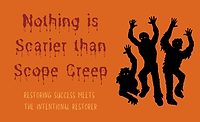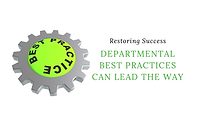Organizational Awareness Can Lead to Greatness
Restoring Success

Photo credit: Mikolette/ E+ Via Getty Images
For years, I have believed that the soft skill piece of organizational awareness is a key to success and can be the root cause of many issues. Most importantly, it is a coachable skill. There are different spins and contexts to this competency, but all have one thing in common and that is that strong organizational awareness skills have a positive impact on individual performance, company objectives and customer service.
Every function, position and individual within the company plays an important role contributing to the results of the company. People who perform consistently excellent typically have a well-developed sense of organizational awareness. As Jon Isaacson states, your focus as an organization is on learning to Do it Right, Do it Efficiently, and Do it Excellently. When those in a position of leadership have a clear understanding of this simple vision, they can create training approaches to develop consistency in these key areas. Organizational awareness is achieved when you align your cultural norms with your stated expectations.
There are two elements to organization awareness:
- External: Understanding of how the organization interacts and presents itself to the outside world. Individuals with a keen understanding of organizational awareness regarding the external world around the organization can represent the company well, prioritize, and serve the customers using this sense and understanding.
- Internal: Understanding of both formal and informal processes of the company, the culture, and how roles and responsibilities impact others and company outcomes.
Simple, Practical Examples:
Driving in a Company Vehicle
Example A: An individual traveling 20 miles an hour over the speed limit cuts somebody off, who swerves and nearly hits another vehicle.
Example B: Another individual slows down on a busy highway so that other vehicles safely merge. While traveling, a stranded driver on the side of the road needs help with a flat tire. The individual pulls over to assist.
The organization prides itself on being professional, courteous and serving others in their time of need. There may be policies and procedures that have been violated, the individual may not be engaged in the values of the company and there is a lack of organizational awareness the aggressive driver showed. The behavior displayed in the driving contradicts how the company interacts and presents itself to the outside world, reflecting negatively on the other employees and the company. On the other hand, even though it may not be in writing, the individual who pulled over to help someone in need did so confidently and showed a keen sense of organizational awareness.
Job Documentation
In Job Documentation: Just Do It, it is noted that developing an individual’s organizational awareness regarding this specific job function could improve the outcome. Someone with strong organizational awareness possesses an understanding of the impact the responsibility has on the workflows, efficiencies, customers, cashflows, company credibility and more. When someone is engaged in the purpose of the company and being a valued team member, organizational awareness can play a factor in their commitment to each task at hand.
In developing The DYOJO Chart for training, Jon Isaacson shares how his team developed an acronym to help technicians and aspiring team leads build their organizational awareness with job documentation. While we all want our teams to perform more efficiently, as getting in and getting out is essential to producing happy customers and profitable jobs, we want to be careful about telling your team to simply go faster. Instead, encourage efficiency and remind them that the key to team speed is S.P.E.D.:
- Scan: Observe the project. Determine the source and extent of damages.
- Plan: Communicate with your team where you will start and what the first steps are so that everyone understands their role.
- Execute: Get to work and adapt your plan as you learn new information on the job.
- Document: We don’t get paid for what we do; we get paid for what we can accurately document.
Organizational awareness can present itself in many aspects of a company and individual performance. The action of changing a password that is needed by others without communicating or notifying them is an example of something seemingly insignificant. This small example illustrates a lack of understanding that others are impacted by the change in password. The result is inefficiency in the operation and frustration put onto others.
People who have good organizational awareness:
- Prioritize work based on an understanding of how it impacts other co-workers, customers, and organization goals and values.
- Effectively communicate and get information to people who need it.
- Exercise care in the execution of their work in context of it impacting co-workers, customers and the organization.
- Positively impact others, increase efficiency, and optimize service.
- Represent the company and values well.
In a recent conversation with Jon Isaacson, he noted the power of being accountable to your co-workers and the power it has on individual performance. This power can be harnessed when we nurture and give organizational awareness. Jon ties things together by noting that business owners love to talk about accountability but often struggle to build and maintain it. If you want to have true accountability you must understand that it is a by-product of clarity. Does your organization have a clear vision and purpose? I’m not talking about having cute posters on the wall with stated values that nobody, including yourself, follows. Rather, what are the core values of your team, your shared philosophy of work and your real habits? You have expectations, but if they are not realistic, you will need to adapt your mindset. Your team has cultural norms, but if these habits are not in alignment with your vision and values, you will need to adjust your approach. With clear expectations and consistent follow-through, you will develop organizational awareness over time, which will promote accountability among team members. When the roles and responsibilities are clear, your team members can better understand what and how their actions impact the team. When Team Member A understands that they are accountable to Team Member B, regardless of their position, then they aren’t just working for a company, they are working for each other.
Some tips to increase and develop organizational awareness in your organization:
- Give it a name and talk about it: Make sure everyone in the company knows what it is and the importance of doing each job with a sense of organizational awareness.
- Performance reviews: Include this soft skill on reviews and acknowledge those who do their duties using this sense and develop/educate those that need help.
- Documented best practices, processes, procedures: As Jon notes, clarity is key.
- Training and employee development: Each person must be given the knowledge, skills and understanding to do their work with organizational awareness.
Looking for a reprint of this article?
From high-res PDFs to custom plaques, order your copy today!







